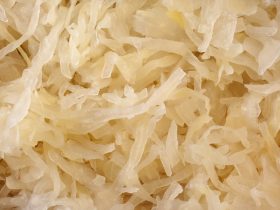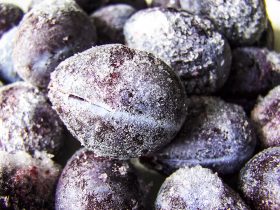Radishes, a root vegetable tangentially related to cabbages and lettuce, were first cultivated and consumed in parts of Central Asia1. Today, they are found in nearly every section of the globe, though the individual species differ wildly.
Most of these species, however, share the same trait of being markedly frost-tolerant, making freezing them easy.
Yes, freezing radishes is entirely possible, though care must be taken to choose the correct produce, as the process of freezing will damage the vegetable’s cell walls.
How Long Will Radishes Keep in the Freezer?
If you choose to keep your radishes in the freezer, they must first be sliced and blanched to minimize the loss of firmness in their texture.
Doing this will allow the radishes to keep shelf-stable for as long a time as six months.
Things Needed for Freezing Radishes
Freezing radishes is somewhat labor-intensive owing to the time and effort needed to blanch them. Because of this, freezing radishes will require a paring knife, a pot, a large enough bowl, ice water, tissues, a stove and air-tight containers to store the vegetables in.
Cutting the Radishes Before Freezing
Choosing to freeze your radishes must first begin by selecting the appropriate produce. The ideal candidate for freezing radishes is one that presents an even red color with no yellow visible in the leaves. Texturally, the radish should be firm and circular in shape3.

Once you have selected the radishes to freeze, scrub thoroughly beneath a stream of cold water. Radishes are root crops, and as such grow beneath the soil, exposing them to dirt and all sorts of bacteria.
As you are washing the radishes, fill a pot with water and bring it to boil on the stove.
Now cleaned, the radishes must be trimmed with a paring knife. Remove the long string-like root growth along the bottom of the radish, as well as the leaves present at the top.
Rinse once more before dicing the radishes into suitably smaller pieces. The size and shape of these is up to your preference.
Leave the radish skin intact as this will help the vegetable retain textural cohesion in the freezer.
Blanching and Freezing the Radishes
Carefully place the diced radishes into the pot of boiling water, ensuring that the water submerges them completely. Stir occasionally so the radishes do not burn at the base of the pot. Leave the radishes in the boiling water for only two minutes, any further will cook them.
As the vegetables are being blanched, prepare a bowl of ice water. After two minutes of boiling, remove the radishes from the pot and plunge them beneath the ice water. Leave them in the ice water for approximately the same amount of time they have been boiled; two minutes.
This will immediately drop the temperature of the vegetable, preventing it from being cooked further by residual heat.
After blanching, place the diced radishes along a length of tissue paper so as to dry them, removing any excess moisture along the surfaces of the pieces. Once dry, simply pile into a freezer-safe container and store in the freezer for up to six months.
How are Radishes Affected by Freezing?
Radishes, like all organic produce, lose quality when subjected to freezing temperatures. Though radishes grow quite well in cool weather, the extremely low temperature of a freezer will rupture and damage them at a cellular level.
Blanching, which is the process of boiling and then rapidly cooling fresh produce, helps alleviate the loss of quality by reducing any enzymes within the produce itself.
In radishes, this means that blanching will slow down its own natural decomposition. As an added effect, the heat of boiling water will disturb the formation of bacteria and fungi colonies in the vegetable.
Thawing Radishes After Freezing
While freezing radishes is a relatively time-consuming process, thawing them is far easier.
In order to defrost radishes, first remove the needed amount from the container, then place in a colander or similar kitchen equipment.
Run the vegetables underneath room-temperature water for several minutes or until they have returned to their partially-supple texture.
Can You Store Radishes Outside the Freezer?
In the event that your freezer is full, radishes can keep their edibility for up to four days on the counter-top2, providing that you adhere to the few simple steps below.
How to Store Radishes Outside the Freezer
All that is needed to store radishes at room temperature is a bowl and a source of water.
First, find a sufficiently large enough bowl to contain the radishes to be stored. Place the vegetables within this bowl, and arrange them in such a way that the base of the roots are facing downward, leaving the leaves and stem upright.
Fill the bowl with either cool or room temperature water. Do not use hot water as this will cause the radishes’ skin to split.
Change the water of the bowl daily, so no bacterial cultures or decomposition by-products build up. Using this technique, your radishes can last for as long as four days out in the open.
Signs of Spoilage in Radishes
Apart from choosing produce appropriate for freezing, it is also important to ensure that your radishes are not spoiled upon purchasing.
Signs of spoilage in radishes are mostly visual, and easy to identify.
If the radishes are losing their usual red color and instead begin taking on a brown or black coloring, it is best to dispose of them, as this signifies enzyme-based decomposition.
Off-color patches or growths along the bulb may also be a sign of fungal growth. Do not attempt to salvage the rest of the vegetable. Should you notice mold growth, throw the entire radish in the trash.
And lastly, if the radishes present a sulfur-like odor, it has been colonized by bacteria, warranting immediate disposal.
References:
1. Zohary, Daniel; Hopf, Maria (2000). “Domestication of plants in the Old World” (3rd ed.). Oxford
2. Unknown author. (January 2009). “Radishes” Texas A&M University https://aggie-horticulture.tamu.edu/food-technology/nutrition/radishes/
3. Unknown Author. (January 1997) “United States Standards for Grades of Radishes” U.S. Department of Agriculture





Hi, I'm Dom
Dom Eats was started to help other people fall in love with food. While cooking can feel intimidating, it doesn't have to be.